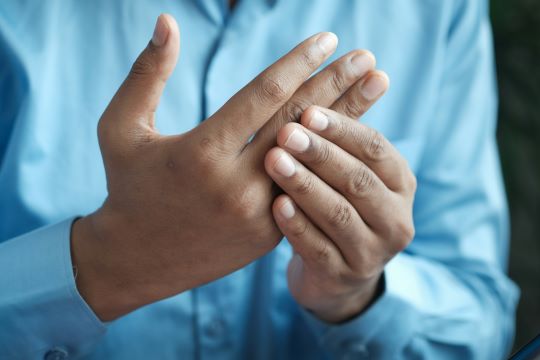Do you find yourself struggling with chronic joint pain? You’re not alone. According to the Centers for Disease Control and Prevention (CDC), an estimated 15 million adults in the United States report severe joint pain. This joint pain is considered chronic when it lasts for more than six weeks. Chronic joint pain can be caused by various conditions such as arthritis, fibromyalgia, bursitis, gout, and lupus. It can significantly affect a person’s daily activities and overall quality of life. If you’re experiencing chronic joint pain, here are some steps that you can take to manage and improve your condition:
Visit the Doctor
When you live in chronic pain, it’s essential to seek medical help. A visit to the doctor can help you determine the underlying cause of your joint pain and develop an appropriate treatment plan. Your doctor may refer you to a knee gel injections specialist if you suffer from severe knee pain or to a rheumatologist if you have arthritis symptoms. They may also recommend physical therapy or medication to manage pain and improve joint mobility.
Most chronic joint pain can be managed with medication, physical therapy, lifestyle changes, and other non-invasive treatments. However, in some cases, surgery may be needed to alleviate the pain and improve joint function. If your doctor recommends surgery, make sure to carefully weigh the risks and benefits before making a decision.
Stay Active
One common misconception about chronic joint pain is that resting can help alleviate the pain. However, prolonged rest or inactivity can worsen the pain by causing stiffness in joints and weakening muscles. Maintaining an active lifestyle and engaging in low-impact exercises such as swimming, cycling, or yoga is essential. These activities can help improve joint flexibility, strengthen muscles, and reduce pain.
Alternatively, your doctor may recommend specific exercises or physical therapy to target the affected joints and alleviate pain. For instance, if you have knee pain, your doctor may suggest exercises to strengthen the muscles around the knee joint. It’s important to follow your doctor’s recommendations and listen to your body to prevent further injury or aggravation of existing conditions.
Incorporate Anti-inflammatory Foods into Your Diet
Certain foods have anti-inflammatory properties that can help reduce joint pain and inflammation. These include fatty fish like salmon, tuna, and sardines, which are high in omega-3 fatty acids. Other anti-inflammatory foods include leafy greens, berries, nuts, and seeds. Incorporating these foods into your diet can help manage chronic joint pain and improve overall health.
On the other hand, certain foods can exacerbate joint pain and inflammation. These include processed foods, sugar, and saturated fats. Limiting or avoiding these foods can also help improve your condition. Most importantly, stay hydrated by drinking plenty of water throughout the day.
Manage Stress
Stress can worsen chronic joint pain by causing muscle tension and increasing inflammation. Finding ways to manage stress and relax your mind and body is essential. This could include:
Practicing mindfulness meditation or deep breathing exercises
Engaging in a hobby or activity that you enjoy
Spending time in nature
Getting enough sleep and rest
It’s essential to find healthy coping mechanisms to manage stress rather than turning to unhealthy habits like smoking or excessive alcohol consumption, which can also worsen joint pain. Try seeking support from friends, family, or a therapist if you’re struggling with stress management.
Practice Good Posture
Poor posture can put undue strain on your joints, leading to increased pain and discomfort. Maintaining good posture when sitting, standing, and walking is essential to prevent further strain on your joints. Sit straight with your feet flat on the floor and avoid hunching or slouching.
If you have a desk job, invest in an ergonomic chair and take regular breaks to stretch and move around. When standing, distribute your weight evenly on both feet and avoid locking your knees. Practicing good posture can help alleviate joint pain and improve overall body alignment.
Explore Complementary Therapies
Aside from traditional medical treatments, complementary therapies can also help manage chronic joint pain. These include acupuncture, massage therapy, and chiropractic care. While the effectiveness of these therapies may vary for each individual, many people have found relief from their joint pain through these alternative methods.
Discussing any complementary therapies with your doctor before trying them out is essential. They can also provide recommendations or referrals to reputable practitioners in your area. Additionally, do thorough research and choose a certified practitioner for any complementary therapy you pursue.
Use Heat and Cold Therapy
Applying heat or cold to affected joints can significantly reduce pain and inflammation. Heat therapy, through warm baths, heat pads, or warm towels, can relax muscles and improve blood circulation, which helps relieve pain and stiffness. Cold therapy, such as with ice packs or cool compresses, can reduce inflammation and numb the surrounding area of a painful joint, providing immediate relief.
You can experiment with both methods to find what works best for you. Some people prefer alternating between hot and cold therapy, while others find more success with one over the other. Remember to follow proper safety precautions, such as not applying heat or cold therapy for too long and protecting your skin from extreme temperatures.
Consider Weight Management
Maintaining a healthy weight is crucial for managing chronic joint pain. Excess weight puts additional pressure on weight-bearing joints such as the knees, hips, and ankles, increasing pain and further damage. A doctor or nutritionist can help create a personalized weight management plan, combining a healthy diet with suitable exercises that do not strain the joints.
A balanced diet and regular exercise are the best ways to manage your weight. Aim to incorporate more fruits, vegetables, lean proteins, and whole grains into your meals and limit processed foods and sugary drinks. Additionally, low-impact exercises such as swimming or cycling can help you burn calories without putting too much strain on your joints.
Managing chronic joint pain may require a combination of these strategies, and it’s essential to be patient and consistent in your efforts. Every individual’s experience with chronic joint pain is unique, so listen to your body and work closely with your doctor to develop a personalized treatment plan. With the right approach, you can improve your quality of life and reduce the impact of chronic joint pain. Remember never to give up hope and keep exploring different options until you find what works best.
The post What You Need to Do if You’re Experiencing Chronic Joint Pain appeared first on South Florida Caribbean News.







